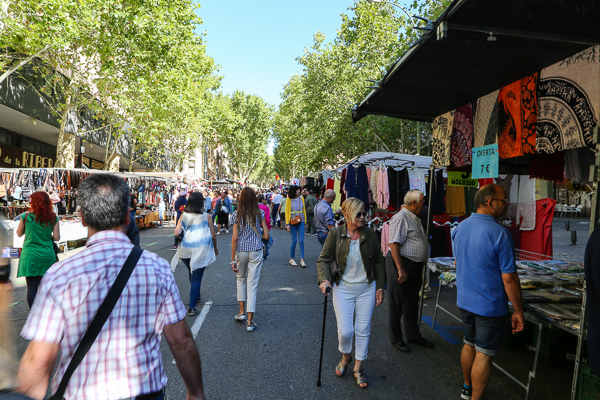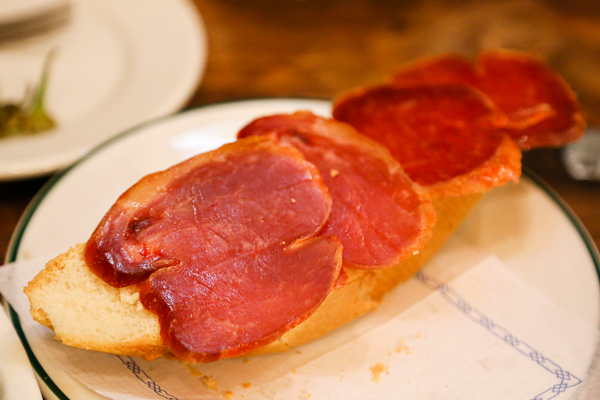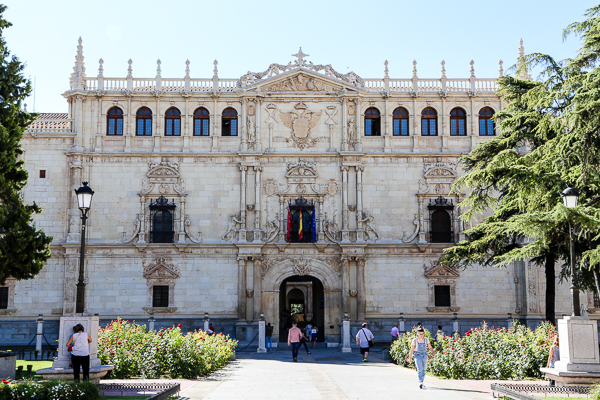
From Castillian pig's ears to Galician razor clams to Andalusian red shrimps and more, Madrid's culinary scene is a chaotic yet effortless amalgamation of diverse culinary traditions from all corners of the Iberian Peninsula. With thousands of restaurants to choose from, we stuck with the most traditional, time-honoured eateries for classic Madrileño flavors.
BREAKFAST:CHOCOLATERIA SAN GINES (Madrid)Location Map
Whether you're waking up early from jetlag or stumbling after an all-nighter at the club, there's no better place to start a new day in Madrid than this legendary 24-hour churreria at the city centre. For more than 120 years, Chocolateria San Gines has served generations of Real Madrid players and local celebrities their routine of Porras and Cafe con Leche at this inconspicuous dead-end alley just west of Puerta del Sol.

Some airy Porras or the crunchier Churros? That's the perpetual question for every customer picking up this prototypical Spanish take-out breakfast. On this day we ordered two scrumptious Porras to go with the signature cup of thick, dark chocolate. An early morning dose of 19th century elegance hardly comes any cheaper, right?
Bill for Two Persons| Chocolate con 2 Porras | 4 Euros |
| TOTAL | 4 Euros (CAD$6) |
It does get even cheaper actually. Just steps from Chocolateria San Gines stands another Madrileño favorite renowned for its delectable pastries since Year 1894, for less than 2 euros a piece.
PASTELERIA LA MALLORQUINA (Madrid)Location Map
Situated smack-dab on Puerta del Sol, the indisputable heart of Madrid and Kilometre 0 of all Spanish roads, La Mallorquina transcends gastronomy into modern Spanish history and the collective memory of all Madrileños. Behind perpetual crowds buzzing along the glass counters is a little staircase to the second floor cafeteria that served as a political hotbed leading up to the Spanish Civil War ... and that was over 80 years ago. This place is a legend amongst Madrid's legendary eateries.

Don't be intimidated by the enormous crowds awaiting their spots at the ground-level cafeteria. Try to make eye contact with the staff behind the glass counter and -- here's the difficult part -- be quick and decisive with your takeout choices! A couple of pillowy Suizos perhaps? Or some crunchy Palmeras? Or maybe a classic Napolitana ... oh wait ... now I have to choose between three different flavors!

Our choice this morning was a crisp, buttery Napolitana filled to the edges with luscious custard cream, along with a mysterious, orange-sized orb known as Trufa Grande that many locals seemed to be ordering.

It turned out to be a chocolate lover's dream, a giant ball of dense chocolate mousse sprinkled with even more chocolate. I cannot emphasize enough the incredible silkiness of the mousse as it pressed against the tip of my tongue -- this instantly became my favorite dessert of this 16-day journey, at a cheap 1.9 euros.
Bill for Two Persons| Napolitana de Crema | 1.3 Euros |
| Trufa Grande | 1.9 Euros |
| TOTAL | 3.2 Euros (CAD$4.8) |

A great place to walk off that rich ball of chocolate mousse is El Rastro, a ginormous open air market sprawling over multiple city blocks from Ronda de Toledo all the way to La Latina metro station every Sunday morning. From quaint bullfighting posters personalized with your name to one-of-a-kind artisan wallets, the wide range of knickknacks provides enough amusement such that even non-shoppers like ourselves ended up spending about 80 euros.
LUNCH:Coincidentally or not, the area immediately north of El Rastro happens to be home to many of Madrid's time-honoured restaurants and taperias, the oldest being the 300-year-old Sobrino de Botin. Here we began a unhurried afternoon of Tapeando, the local pastime of hopping from one gastropub to the next in search of one's favorite Tapas.
CASA REVUELTA (Madrid)Location Map
This is another of Madrid's oldest eateries, dating from Year 1860 when the idea of a Spanish Republic was still a daydream. Locating Casa Revuelta is easy; you really can't miss its large crowd of faithfuls attempting to squeeze into the tiny taperia. At one point I considered giving up, but we persisted for about 10 minutes and eventually found a fortuitous opening to the counter.

"Dos cañas y dos pinchos de bacalao" was the magical phrase that I had to rehearse in my head -- there was no time to waste at the counter with two dozen people waiting for my spot. But ordering was relatively simple as the kitchen churned out just one legendary item: baskets upon baskets of deep-fried bacalao, a hundred kilograms a day in fact.

It was worth the wait -- the batter was magically crispy, and the bacalao was so succulent that I was almost licking the juices running down my forearm. The codfish was minimally seasoned with nothing but salt, but why would anyone need more seasoning when you've got fish this fresh?

We spent less than 10 minutes at the bar counter before giving up our spot for the next guy, but not before the essential routine of tossing the dirty servilleta on the floor like everyone else. You know this taperia is legit when you can hardly take a step without stepping on a serviette ... or a pincho skewer.
Bill for Two Persons| Pincho de Bacalao x 2 | 6 Euros |
| Caña x 2 | 2.4 Euros |
| TOTAL | 8.4 Euros (CAD$12.6) |
Barely a hundred metres down the street, the same Tapeando crowd can be found buzzing around another popular eatery famous for a different sort of Tapa.
MESON DEL CHAMPIÑONES (Madrid)Location Map
Compared with the centuries-old Sobrino de Botin and Casa Revuelta on the same block, Meson del Champiñones is a relative newcomer at 60-years-young. A small and somewhat inconspicuous storefront belies a literally cavernous interior where a disproportionately tourist-filled crowd -- thanks apparently to Japanese guidebooks -- packs the interior mainly for the one celebrated dish.

Rather than standing at the bar counter, we settled for a sit-down lunch of Tapas starting with one of my favorite Spanish dishes, the ubiquitous Pimientos de Padron with their smoky skin, flavorsome flesh and no seasoning other than rock salt. Seriously I have never come across a plate of Pimientos de Padron anywhere in Spain that I didn't like.

Our appetite was well-primed for the restaurant's namesake, the one stellar dish that graced every table and filled the whole vaulted room with the unmistakeable fragrance of fried garlic. A ridiculously simple combination of mushrooms, Jamon Iberico, garlic, olive oil, and dry sherry, Champiñones al Ajillo is one of those rustic dishes that truthfully reflects the quality -- in this case very favorably -- of the raw ingredients.

In fact we probably could have ordered one more plate of Champiñones instead of this Pincho de Lomo -- not that we didn't enjoy the dry-cured pork loin, but the garlic mushrooms were head and shoulders better than everything else. Given the slightly inflated prices I would recommend dropping by simply for a caña and some champiñones, and combine with Casa Revuelto for a light lunch.
Bill for Two Persons| Pimientos de Padron | 7.9 Euros |
| Champiñones al Ajillo | 7.3 Euros |
| Pincho de Lomo | 4.9 Euros |
| Botella de Cerveza x 2 | 6.4 Euros |
| Bread Charge x 2 | 2 Euros |
| TOTAL | 27.5 Euros (CAD$41.2) |

Another 50 metres ahead and we've reached the famous Mercado San Miguel with dozens of gourmet taperia stands, pastelerias and fishmongers vying for most tourist business under its century-old iron frame. Its dubious reputation for Spain's most skilful pickpockets -- and inflated prices -- meant that it was probably wise to arrive on full stomach and enjoy the atmosphere on the sideline.

But I couldn't resist visiting the fishmonger upon the sight of a finished shell of fresh sea urchin on a table, only to learn that the day's catches were mostly sold out. A couple pieces of artisan Baklava were all that we purchased before heading back for a little siesta.
DINNER:CASA TONI (Madrid)Location Map
If I have to pick one tapas bar that best represents the authentic Madrid, this is it.
I've sat next to the window and watched dozens of English-speaking tourists horrified by the mystery meats at the storefront. Squeamish eaters should scroll down to the next restaurant review for some garlic shrimp, but if you're curious about what the Madrileños really enjoy, without any prejudice, then this hole-in-the-wall place is a MUST VISIT.

Skip the sight of uncooked entrails and pig ears if you must, but you cannot escape the 1960s decor while you get seated with your glass of Rioja, or perhaps Tinto de Verano, which would invariably come with a free tapa such as these pinchos of Jamon York with a dash of paprika. As rough-around-the-edges as this small gastrobar may appear, this is the real, unadulterated Madrid for its generations of faithfuls.

The menu is dominated by home style dishes like this generous plate of deep-fried eggplants with honey or stewed beef tripes with chorizo and chickpeas. The greasy smoke and aroma of seared pork fat was emanating from the hotplate behind the counter as we patiently waited for the shop's most popular creation ...

Orejas a la Plancha, or grilled pig ears, perfectly charred, crunchy as expected on the bite and served with thick, spicy Bravas sauce on the side. While we did have previous exposure to pig ears mainly from
Sichuanese dishes, the richness of flavors and texture made these Orejas a surprisingly great match for a glass of Rioja. And at a cheap 5.5 euros (CAD$8.25), this excellent tapa might just be the best deal we came across in Madrid.

Finally, the famous ingredient that helps drive away the odd unsuspecting tourist from the display window and elevates Casa Toni as one of Madrid's most beloved eateries for Casqueria, or offal meats. It also happened to be our first ever encounter with the euphemistically named lamb sweetbread, i.e. the thymus gland of lamb.
Seared on the hotplate and sprinkled with a heavy dose of chopped herbs, this Mollejas a la Plancha really surprised us with a firm, meaty texture compared with its limp and mucus-laden appearance behind the display counter when raw. My tastebuds probably craved the Orejas even more, but there's a certain mystery to the Mollejas that added to the dish's Old World charm. At the end we paid 13 euros per person for dinner including a drink, certainly a bargain within 5 minutes' walk from Puerta del Sol.
Bill for Two Persons| Berenjenas | 6 Euros |
| Orejas a la Plancha | 5.5 Euros |
| Mollejas a la Plancha | 9.5 Euros |
| Glass of Sangria | 2.5 Euros |
| Glass of Rioja Crianza | 2.6 Euros |
| TOTAL | 26.1 Euros (CAD$39.2) |
That little stretch of Calle de la Cruz soon became our go-to spot for dinner, not only because it was a 3 minute walk from our rental apartment, but mainly for the convergence of two of our favorite Tapas bars -- Casa Toni and Casa del Abuelo.
CASA DEL ABUELO (Madrid)Location Map
Just 30 metres down the block from Casa Toni stands an even older establishment, famous also for its own Madrileño favorites. Featuring old school wooden counters and optically imperfect mirrors from its 110-year-old history, Casa del Abuelo should fit just about everyone's perfect image of a classic Tapas bar, serving a smallish range of offerings but most renowned for just one dish.

And while we awaited that one stellar dish, we started with some Tomates Aliñado, a popular summery dish of fresh tomatoes in a salty vinaigrette that had the opposite effect of quelling our hunger while the smell of fried garlic from the back kitchen became stronger and stronger. What came next would become one of our best memories of the trip ...

Gambas al Ajillo -- my favorite dish over our 16-day journey across Spain -- served sizzling in a fired earthen Cocido and flavored with little else but garlic, dried cayenne pepper, and perhaps a dash of Sherry by some accounts. The best part wasn't just the shrimp, but the incredibly aromatic oil that we couldn't help mopping it all up with bread!
In fact I was so impressed with this dish that I have since invested the time to learn to emulate it back in Canada. Yet I doubt that I would ever attain this level of heavenly savouriness at home, at least that extra saltiness in the shrimp flesh that clearly pronounced its Mediterranean origin. We ordered Gambas al Ajillo a couple more times in Spain, but this was just a notch above the rest.

Perhaps I should have purchased a few bottles of the housemade garlic-shrimp-infused oil -- available for about 10 euros -- and lugged them back to Canada. I still have to master the art of frying shrimp shells to extract that crustacean flavor for the oil, and can't wait to add this to my regular rotation of comfort dishes at home.
Bill for Two Persons| Tomates Aliñado | 6.5 Euros |
| Gambas al Ajillo | 10.9 Euros |
| Glass of Tinto de Verano | 2.6 Euros |
| Glass of Sangria | 2.6 Euros |
| Bread Charge x 2 | 1.2 Euros |
| TOTAL | 23.8 Euros (CAD$35.7) |
The above six eateries are all 50-plus-year-old institutions located conveniently within a short walk from the absolute centre of Madrid, namely Puenta del Sol and Plaza Mayor. But one night we also ventured a little south to the vibrant, multi-ethnic neighbourhood of Lavapies for a small and completely packed Tapas bar recommended to us by a local.
LA BERENJENA (Madrid)Location Map
If popularity with native residents is the ultimate sign of an authentic local eatery, this little gastrobar would surpass all expectations. In fact the lone waitress was so completely overwhelmed that one of the regular clients volunteered to greet these two clueless foreigners. The entire floor was absolutely jam packed to the point of everyone literally spilling drinks on one another, and the only available seats belonged to two tiny, make-shift tables on the way to the washroom at the back.

As uncomfortable as that might sound, it didn't stop the neighbours from swamping the tiny bar so badly that sitting down at a table came with the charge of an extra euro for each dish, a standard strategy to encourage turnover. But not everyone orders formal dishes as one could easily fill up on the free tapas such as this Ensalada Rusa that came with our cañas of beer.

I could not resist ordering our fourth dish of razor clams within our first week in Spain -- it was that addictive. But far from the prototypical Navajas a la Plancha with garlic oil and herbs, this house specialty came with a tropical cream sauce of coconut, cilantro and a squeeze of Sriracha for a kick. The complexity of the sauce might have been slightly distracting from the natural Umami of the razor clams, but it was still a delicious and refreshing combination.

Carrillera de Ternera, a veal cheek slow-braised in wine and topped with a cream of goat cheese and rosemary. While the portion could have been a little more generous, the flavors were very sophisticated for a dim, inconspicuous bar on a residential side street, almost within walking distance from Atocha train station. This place is popular for good reasons.

The best deal of the evening was this beautiful Semicrudo de Entraña, a barely-seared skirt steak in a Provencal sauce featuring a heavy dollop of parsley and generously seasoned with rock salt. At a cheap 9 euros (8 if you're standing at the bar counter) I seriously doubt that you can find a better steak for its price in central Madrid.
Bill for Two Persons| Navajas con Crema de Coco, Lima, Sriracha y Cilantro | 14 Euros |
| Carrillera de Ternera y Crema de Queso al Romero | 13.5 Euros |
| Semicrudo de Entraña y Hierbas Provenzales | 9 Euros |
| Caña x 4 | 6.8 Euros |
| TOTAL | 43.3 Euros (CAD$65) |
So that's it for dinner. What next?
AFTER DINNER:
Craving the quintessential Spanish art form of flamenco but don't fancy paying the 30 to 50 euros charged by most tablaos in central Madrid? Hop on Metro Line 2 to Las Ventas bullring and walk over to the dark and cramped Cafetin la Quimera where clients sit at most 20 feet away from the intricate footwork (and thunderous taconeos!) in the most intimate setting. Price for the 1 hour 40 minute performance? Just 17 euros at the time of writing.
SLEEP:
As mentioned above, we rented an apartment within a short walk from most of the above tapas bars, and a 5 minute walk from Puerta del Sol, the undisputed centre of Madrid and a major transport hub for Metro and Cercanias trains ... all for a cheap price about 60% of the cost of our Barcelona apartment. There were two catches though -- there was no air conditioning, and the loft bedroom was accessible via a steep flight of stairs. Search up L&H Plaza Santa Ana if interested.




























































